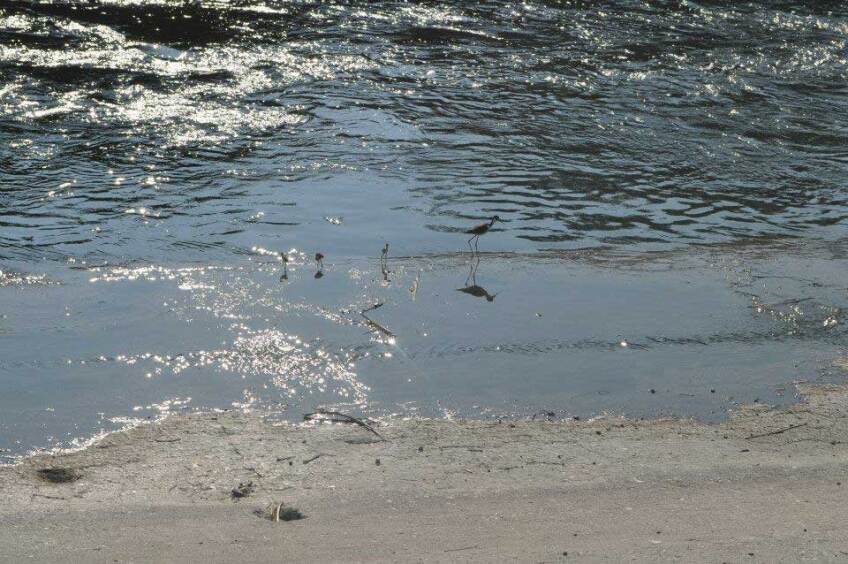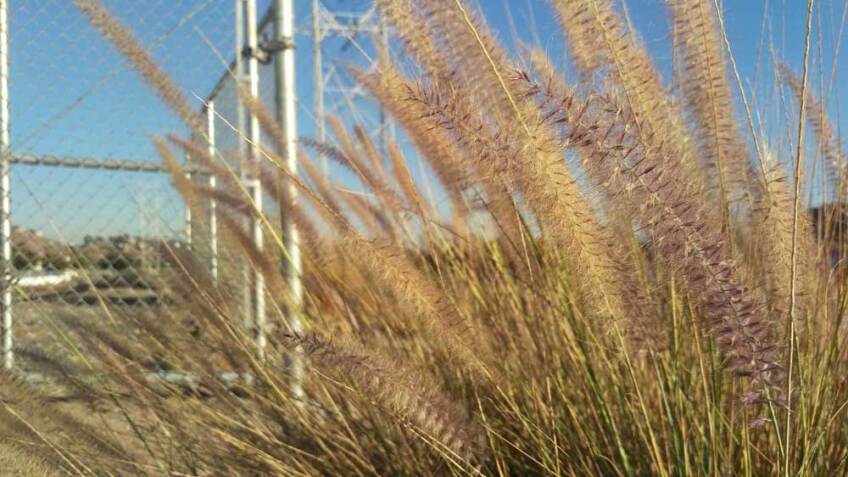The G2 Parcel: Let’s Get Real on the Los Angeles River

Published as part of an environmental storytelling partnership with the Laboratory for Environmental Narrative Strategies (LENS) at the University of California, Los Angeles. The first storyline focuses on the past, present and possible futures of Taylor Yard, an abandoned and contaminated rail yard adjacent to the L.A. River. Find more stories about Taylor Yard here.
During a recent visit to a Cheesecake Factory, I was struck by the similarities between the restaurant’s grandiose décor and the ambitious visions for the future of the L.A. River.
Many renderings of the future of the L.A. River in the city’s “Los Angeles River Revitalization Master Plan” conjure up feelings of a chic and fancy river. Taylor Yard, a contaminated former railroad yard also known as the G2 parcel, is at the center of the city’s efforts to “enhance and restore the river’s nature,” according to the Los Angeles Bureau of Engineering.
However, there’s something about the implications of this revitalization, and even the language used to describe it, that make me feel uneasy.
I understand why the words “revitalization” and “restoration” are used on the river. They sound good and they imply we are fixing something that we broke, making amends. Also, the “Los Angeles River Revitalization Master Plan” sounds better than “Changing the Los Angeles River Plan.” However, to revitalize something means to give it a new life, which implies that the life it currently has is something we don’t want or value.
It’s easy to say “revitalize” and create utopian images of humans and nature living in harmony. But let’s get real. This is our opportunity to go deeper together.

Talk of revitalizing the L.A. River reminds me of conversations I overhear about downtown Los Angeles being better today because in the 90’s there was “nothing there” and it was empty at night. It’s true that my family and I did not spend time in downtown at night in those days. To be fair to downtown, we never went out at night when I was growing up in Koreatown. Downtown L.A. during the day was a totally different story; the streets and alleys or callejones were filled with people buying Quinceañera dresses and table decorations, blankets, and gold jewelry. When we did go downtown at night for special occasions, we would go to Clifton’s Cafeteria for dinner. I particularly remember Christmas there being a real treat because the kids got presents. Also, I’ll never forget Las Fiestas Broadway in the early 90’s. Hundreds of thousands of people attended this daytime block party in downtown featuring well-known Latin American artists like La Sonora Dinamita, a cumbia group that my family loves and still listens to. Now, downtown L.A. is “DTLA” and it is being “revitalized,” just like the L.A. River will be.
But what is at the river now?

Well, definitely a lot of animals. Since not many people visit Taylor Yard, I can sit quietly alone and observe some of my favorite creatures when I go there. The sun shines on the golden brown San Gabriel Mountains and the water from the Glendale Water Reclamation Plant trickles around the trees and tall grass growing between the river’s cement cracks. Mallards, egrets, and belted kingfishers find food and shelter there. A black-necked stilt and its baby walk down the cement banks, unnoticed by most, learning how to navigate this incredible manmade ecosystem. The birds here are not shy and the cement banks make for an open landscape not often found in riparian ecosystems, making it easier to observe their every move. A red-tailed hawk stands resolutely atop a transmission tower, waiting for an unsuspecting mouse or cottontail bunny to dash out of the bushes. Or maybe just to get a nice view of the city. Another bird calls out its own name incessantly in the distance: “killDEER… killDEER… killDEER.” The water flows continually and the squawking brings me a sense of peace. I forget I’m in Los Angeles.
As magical as the L.A. River and Taylor Yard are to me and a few other people, access is limited now. I don’t usually see many people out there, which is nice for me but seems selfish.
However, as much as I would want to share this view with others, Taylor Yard is definitely polluted. The site is called a “brownfield” because it is contaminated. I can’t bring my family here now and won’t be able to for some time.
The “Final Remediation Action Plan” put together by Union Pacific, the railroad company that sold the G2 parcel to the city, provides a window into the problems the city inherited when it purchased the land. The document indicates that in some parts of the G2 parcel, lead contamination, which can cause brain damage with prolonged exposure, exceeds the U.S. Environmental Protection Agency’s safety levels.
But lead is not the only pollutant in the soil. Since this land was a railyard, and leaks and spills of chemicals occurred, the soil also has total petroleum hydrocarbons (TPH). This TPH comes from diesel fuel the trains ran on.

Can TPH harm people? To begin answering this question, I used the chemical equilibrium partitioning and compartmentalization model I learned in my class about organic chemicals in the environment. (Since TPH has carbon, it is “organic,” though not at all in the colloquial sense we use the word today.)
The point of this model is to figure out where a chemical is found in the environment — the air, soil, or water — and how to clean it up or limit human exposure. I searched for TPH’s physical characteristics to run my model: molecular weight, water solubility, vapor pressure, melting point, and boiling point. This basic information was difficult to find.
After several attempts to run the model, I realized that I was trying to answer the wrong question. Before I begin to answer where the chemical is in the environment, I have to know which compound I am looking for. And it turns out that TPH refers to several hundred types of hydrocarbons, compounds whose bonds are composed of hydrogen and carbon. You breathe in similar compounds when filling your car with gasoline. Some examples of TPH compounds include naphthalene, toluene, xylene and benzene, which the Agency for Toxic Substances and Disease Registry lists as a substance that could cause cancer. With some parts of Taylor Yard showing TPH concentrations of up to 54,000 parts per million, now you understand why I can’t bring my family here just yet.
That said, the nature that is reclaiming the site already, on its own, is admirable. Take fountain grass (Pennisetum setaceum). This immigrant, like myself, establishes roots in this polluted land and is able to thrive. I feel a sort of kinship with this nonnative, which might be considered invasive by some.
While I agree that the soil here needs to be cleaned up, either by removing it entirely or through phytoremediation — using plants that take up the chemicals in the soil — I like the fountain grass that is reclaiming the site on its own, and the shy coyote that darts among the plants, and the Say’s Phoebe that sits on the chain-link fence singing its own tune. So I feel hesitant about a complete overhaul.

I’m an ecologist and I find restoration projects intriguing because we sometimes rely on our ability to restore habitats to justify our destruction of others. The L.A. River is home to numerous animals now. Are we hoping that by destroying, or changing the area, we will get more of what is there now? Or will we get something better?
My perspective is deeply influenced by "The Myths of Restoration Ecology”, a paper by Robert Hilderbrand, Adam Watts, and April Randle that appeared in the journal Ecology and Society. Their point is not that restoration should never be done, but that to avoid being disappointed in the future, it’s important to be aware of the myths under which we are operating and the assumptions we are making. The “L.A. River Ecosystem Restoration Plan,” for example, falls under the “Field of Dreams” myth. It assumes that if we plant natives and make riparian habitat, ecosystem values will come. I believe that eventually nature re-establishes itself, but maybe not in the form that people are envisioning, and perhaps, instead, in the form of more non-native species, though I don’t have a problem with that. Also, after the riparian habitat is “restored,” this habitat will still be within our megalopolis. Motor oil and dog poop will still run through it, just as before.
Looking past the plan’s romanticized drawings of the river’s past and future, there are a few key things that the river and our urban ecosystem do need. Decreasing the amount of concrete to improve water permeability is important for water infiltration and to reduce the amount of pollution that courses down the river and fouls our surf and beaches. Increasing the amount of wild space is important if we want more wildlife, which I do, and I think most people really enjoy. Finally, perhaps having more people at Taylor Yard can bring awareness of the impact we have on our whole watershed, from the pollution that industrial activities cause, to the way the chemicals we put on our lawns contribute to fouling the river and ocean off our coast.

I agree that Taylor Yard presents a great opportunity to revitalize our relationship with the ecosystem in which we live.
But I worry. Are we stuck at a surface level here?
Can we envision a river that is less like the Cheesecake Factory, which seeks to create an illusion of opulence while serving ordinary, over-filled plates? Instead, can we perhaps create a river that is more like the hole-in-the-wall restaurant on a callejon that we pass every day and don’t always appreciate, but is unexpectedly, delightfully complex and delicious?
I imagine a space devoid of lead and TPH, but that retains some of the undefined wildness that exists at Taylor Yard today. I see a place where we refuse to use toxic chemicals, even if that means relinquishing some control and embracing weeds. I envision a place to sit and contemplate, or watch skateboarders do their thing; maybe a place to grill a carne asada and share the latest family gossip. Let’s let Taylor Yard be what it wants to be — a true urban wilderness — rather than impose a grand vision that fulfills civic ambitions but constrains possibilities.





